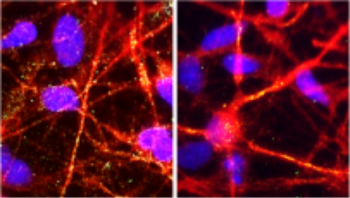
News & Events
News & Events
Home › News & Events › 2013 › Research › Modeling Alzheimer's disease using iPSCs reveals stress phenotypes associated with intracellular Aβ and differential drug responsiveness
News
February 22, 2013
Modeling Alzheimer's disease using iPSCs reveals stress phenotypes associated with intracellular Aβ and differential drug responsiveness
Working with a group from Nagasaki University, a research group at the Center for iPS Cell Research and Application (CiRA) has successfully modeled Alzheimer's disease (AD) using both familial and sporadic patient-derived induced pluripotent stem cells (iPSCs), and revealed stress phenotypes and differential drug responsiveness associated with intracellular amyloid β oligomers in AD neurons and astrocytes.
In a study published online in Cell Stem Cell, Associate Professor Haruhisa Inoue and his team at CiRA and a research group led by Professor Nobuhisa Iwata of Nagasaki University generated cortical neurons and astrocytes from iPSCs derived from two familial AD patients with mutations in amyloid precursor protein (APP), and two sporadic AD patients. The neural cells from one of the familial and one of the sporadic patients showed endoplasmic reticulum (ER)-stress and oxidative-stress phenotypes associated with intracellular Aβ oligomers. The team also found that these stress phenotypes were attenuated with docosahexaenoic acid (DHA) treatment. These findings may help explain the variable clinical results obtained using DHA treatment, and suggest that DHA may in fact be effective only for a subset of patients.
Using both familial and sporadic AD iPSCs, the researchers discovered that pathogenesis differed between individual AD patients. For example, secreted Aβ42 levels were depressed in familial AD with APP E693Δ mutation, elevated in familial AD with APP V717L mutation, but normal in sporadic AD.
"This shows that patient classification by iPSC technology may contribute to a preemptive therapeutic approach toward AD," said Inoue, a principal investigator at CiRA who is also a research director for the CREST research program funded by the Japan Science and Technology Agency. "Further advances in iPSC technology will be required before large-scale analysis of AD patient-specific iPSCs is possible."
 Aβ oligomers in neurons from a familial AD (APP-E693Δ) (left) and from a sporadic AD patient (right)
Aβ oligomers in neurons from a familial AD (APP-E693Δ) (left) and from a sporadic AD patient (right)Green: Aβ oligomers, Blue: Cell Nuclear, Red: Neuron.
COURTESY OF DR. HARUHISA INOUE'S LABORATORY
<Journal Information>
Title of Paper
Authors
Takayuki Kondo, Masashi Asai, Kayoko Tsukita, Yumiko Kutoku, Yutaka Ohsawa, Yoshihide Sunada, Keiko Imamura, Naohiro Egawa, Naoki Yahata, Keisuke Okita, Kazutoshi Takahashi, Isao Asaka, Takashi Aoi, Akira Watanabe, Kaori Watanabe, Chie Kadoya, Rie Nakano, Dai Watanabe, Kei Maruyama, Osamu Hori, Satoshi Hibino, Tominari Choshi, Tatsutoshi Nakahata, Hiroyuki Hioki, Takeshi Kaneko, Motoko Naitoh, Katsuhiro Yoshikawa, Satoko Yamawaki, Shigehiko Suzuki, Ryuji Hata, Shu-ichi Ueno, Tsuneyoshi Seki, Kazuhiro Kobayashi, Tatsushi Toda, Kazuma Murakami, Kazuhiro Irie, William L. Klein, Hiroshi Mori, Takashi Asada, Ryosuke Takahashi, Nobuhisa Iwatasend email, Shinya Yamanaka, Haruhisa Inoue






















